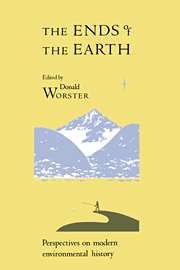Book contents
- Frontmatter
- Contents
- Preface
- INTRODUCTION
- DYNAMICS OF CHANGE
- THE EUROPEAN INVASION
- 5 Ecological Imperialism: The Overseas Migration of Western Europeans as a Biological Phenomenon
- 6 The Depletion of India's Forests under British Imperialism: Planters, Foresters, and Peasants in Assam and Kerala
- 7 Toward an Archaeology of Colonialism: Elements in the Ecological Transformation of the Ivory Coast
- CONSERVING NATURE – PAST AND PRESENT
- CONCLUSION
- Appendix: Doing Environmental History
- Bibliography
- Contributors
- Index
6 - The Depletion of India's Forests under British Imperialism: Planters, Foresters, and Peasants in Assam and Kerala
Published online by Cambridge University Press: 05 June 2012
- Frontmatter
- Contents
- Preface
- INTRODUCTION
- DYNAMICS OF CHANGE
- THE EUROPEAN INVASION
- 5 Ecological Imperialism: The Overseas Migration of Western Europeans as a Biological Phenomenon
- 6 The Depletion of India's Forests under British Imperialism: Planters, Foresters, and Peasants in Assam and Kerala
- 7 Toward an Archaeology of Colonialism: Elements in the Ecological Transformation of the Ivory Coast
- CONSERVING NATURE – PAST AND PRESENT
- CONCLUSION
- Appendix: Doing Environmental History
- Bibliography
- Contributors
- Index
Summary
In the centuries after Columbus reached the Caribbean islands and da Gama arrived on the coast of India, Europe's economic and strategic expansion, one fledgling nation-state rivaling another, was the driving force in domesticating the natural world. In its fundamental legacy, colonialism helped shape a globe whose once vast wildlands are now almost entirely managed to one degree or another. Even the great river-basin civilizations of India and China, home to dense populations before the European era, had extensive wild hinterlands of mountain, jungle, and desert until the past century. But the joint efforts of indigenous people and Western interlopers have now nearly completed the transformation.1 Forests and grasslands have retreated massively before the expansion of settled agriculture, and nowhere more dramatically than in India, where step-by-step between the 1770s and 1850s, Britain established its raj, or imperial regime. From this perspective British rule in India, like other Western empires elsewhere in the developing world, must be seen as an elaborate system of resource extraction and allocation, determining not only who was to have access to nature's wealth but what pattern the biotic systems themselves would ultimately take by the time India gained independence in 1947.
This system of natural resources management was by no means monolithic or unchanging, nor did the British entirely control it. Throughout the imperial era the British administered two-thirds of the Indian subcontinent directly but left the remaining third under the autonomous rule of over five hundred indigenous aristocratic houses, the “Native Princes.”
- Type
- Chapter
- Information
- The Ends of the EarthPerspectives on Modern Environmental History, pp. 118 - 140Publisher: Cambridge University PressPrint publication year: 1989
- 22
- Cited by

